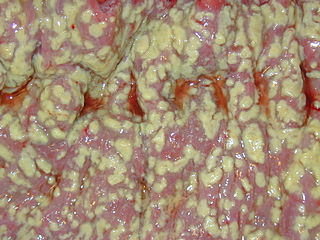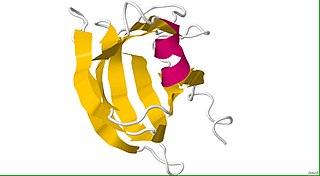Related Research Articles

Botulism is a rare and potentially fatal illness caused by a toxin produced by the bacterium Clostridium botulinum. The disease begins with weakness, blurred vision, feeling tired, and trouble speaking. This may then be followed by weakness of the arms, chest muscles, and legs. Vomiting, swelling of the abdomen, and diarrhea may also occur. The disease does not usually affect consciousness or cause a fever.

Clostridioides difficile infection , also known as Clostridium difficile infection, is a symptomatic infection due to the spore-forming bacterium Clostridioides difficile. Symptoms include watery diarrhea, fever, nausea, and abdominal pain. It makes up about 20% of cases of antibiotic-associated diarrhea. Antibiotics can contribute to detrimental changes in gut microbiota; specifically, they decrease short-chain fatty acid absorption which results in osmotic, or watery, diarrhea. Complications may include pseudomembranous colitis, toxic megacolon, perforation of the colon, and sepsis.

Clostridium perfringens is a Gram-positive, bacillus (rod-shaped), anaerobic, spore-forming pathogenic bacterium of the genus Clostridium. C. perfringens is ever-present in nature and can be found as a normal component of decaying vegetation, marine sediment, the intestinal tract of humans and other vertebrates, insects, and soil. It has the shortest reported generation time of any organism at 6.3 minutes in thioglycolate medium.

Fasciolosis is a parasitic worm infection caused by the common liver fluke Fasciola hepatica as well as by Fasciola gigantica. The disease is a plant-borne trematode zoonosis, and is classified as a neglected tropical disease (NTD). It affects humans, but its main host is ruminants such as cattle and sheep. The disease progresses through four distinct phases; an initial incubation phase of between a few days up to three months with little or no symptoms; an invasive or acute phase which may manifest with: fever, malaise, abdominal pain, gastrointestinal symptoms, urticaria, anemia, jaundice, and respiratory symptoms. The disease later progresses to a latent phase with less symptoms and ultimately into a chronic or obstructive phase months to years later. In the chronic state the disease causes inflammation of the bile ducts, gall bladder and may cause gall stones as well as fibrosis. While chronic inflammation is connected to increased cancer rates, it is unclear whether fasciolosis is associated with increased cancer risk.

Gas gangrene is a bacterial infection that produces tissue gas in gangrene. This deadly form of gangrene usually is caused by Clostridium perfringens bacteria. About 1,000 cases of gas gangrene are reported yearly in the United States.

Blackleg, black quarter, quarter evil, or quarter ill is an infectious bacterial disease most commonly caused by Clostridium chauvoei, a Gram-positive bacterial species. It is seen in livestock all over the world, usually affecting cattle, sheep, and goats. It has been seen occasionally in farmed bison and deer. The acute nature of the disease makes successful treatment difficult, and the efficacy of the commonly used vaccine is disputed.
Hemorrhagic gastroenteritis (HGE) is a disease of dogs characterized by sudden vomiting and bloody diarrhea. The symptoms are usually severe, and HGE can be fatal if not treated. HGE is most common in young adult dogs of any breed, but especially small dogs such as the Toy Poodle and Miniature Schnauzer. It is not contagious.
Clostridial necrotizing enteritis (CNE) is a severe and potentially fatal type of food poisoning caused by a β-toxin of Clostridium perfringens, Type C. It occurs in some developing regions, particularly in New Guinea, where it is known as pig-bel. The disease was also documented in Germany following World War II, where it was called Darmbrand (literally "bowel fire," or bowel necrosis). The toxin is normally inactivated by certain proteolytic enzymes and by normal cooking, but when these protections are impeded by diverse factors, and high protein is consumed, the disease can emerge.

Clostridium septicum is a gram positive, spore forming, obligate anaerobic bacterium.
A clostridial vaccine is a vaccine for sheep and cattle that protects against diseases caused by toxins produced by an infection with one or more Clostridium bacteria. Clostridial vaccines are often administered to pregnant ewes a few weeks before they are due to give birth, in order to give passive immunity to their lambs. Clostridial bacteria multiply rapidly in infected sheep, and produce large amounts of toxin which can cause the sheep to die within hours.
Abomasitis is a relatively rare ruminant disease characterized by inflammation of abomasum usually caused by larval development in young calves, lambs, and goat kids. It occurs with gastroenteritis, but can also be a side effect of other diseases. However, it is seldom diagnosed as a separate condition.

Clostridium enterotoxins are toxins produced by Clostridium species. Clostridial species are one of the major causes of food poisoning/gastrointestinal illnesses. They are anaerobic, gram-positive, spore-forming rods that occur naturally in the soil. Among the family are: Clostridium botulinum, which produces one of the most potent toxins in existence; Clostridium tetani, causative agent of tetanus; and Clostridium perfringens, commonly found in wound infections and diarrhea cases.
Clostridium novyi (oedematiens) a Gram-positive, endospore- forming, obligate anaerobic bacteria of the class Clostridia. It is ubiquitous, being found in the soil and faeces. It is pathogenic, causing a wide variety of diseases in humans and animals.
Pyrrolizidine alkaloidosis is a disease caused by chronic poisoning found in humans and other animals caused by ingesting poisonous plants which contain the natural chemical compounds known as pyrrolizidine alkaloids. Pyrrolizidine alkaloidosis can result in damage to the liver, kidneys, heart, brain, smooth muscles, lungs, DNA, lesions all over the body, and could be a potential cause of cancer. Pyrrolizidine alkaloidosis is known by many other names such as "Pictou Disease" in Canada and "Winton Disease" in New Zealand. Cereal crops and forage crops can sometimes become polluted with pyrrolizidine-containing seeds, resulting in the alkaloids contaminating flour and other foods, including milk from cows feeding on these plants.
Colitis X, equine colitis X or peracute toxemic colitis is a catchall term for various fatal forms of acute or peracute colitis found in horses, but particularly a fulminant colitis where clinical signs include sudden onset of severe diarrhea, abdominal pain, shock, and dehydration. Death is common, with 90–100% mortality, usually in less than 24 hours. The causative factor may be Clostridium difficile, but it also may be caused by other intestinal pathogens. Horses under stress appear to be more susceptible to developing colitis X, and like the condition pseudomembranous colitis in humans, an association with prior antibiotic use also exists. Immediate and aggressive treatment can sometimes save the horse, but even in such cases, 75% mortality is considered a best-case scenario.

Nutritional Muscular Dystrophy is a disease caused by a deficiency of selenium and vitamin E in dietary intake. Soils that contains low levels of selenium produce forages and grains that are deficient in selenium. Similarly, if the forage is of low quality or is not stored properly it may be deficient in vitamin E. If an animal consumes this type of diet without additional supplementation they become susceptible to this disease. This condition often affects young ruminants, such as calves and lambs.
Malignant edema is an acute, generally rapidly fatal wound infection (toxemia) most common in grazing animals. It affects cattle, horses, sheep, goats, pigs, and deer. It is caused by one or more species of bacteria in the genus Clostridium.
Clostridium perfringens beta toxin is one of the four major lethal protein toxins produced by Clostridium perfringens Type B and Type C strains. It is a necrotizing agent and it induces hypertension by release of catecholamine. It has been shown to cause necrotic enteritis in mammals and induces necrotizing intestinal lesions in the rabbit ileal loop model. C. perfringens beta toxin is susceptible to breakdown by proteolytic enzymes, particularly trypsin. Beta toxin is therefore highly lethal to infant mammals because of trypsin inhibitors present in the colostrum.
References
- ↑ Alabama Cooperative Extension System. 2007. Enterotoxemia (Overeating Disease) in Sheep and Goats. Retrieved from http://www.aces.edu/pubs/docs/U/UNP-0089/UNP-0089.pdf
- 1 2 "Enterotoxemias". Merck Veterinary Manual. Merck. Retrieved 2017-04-06.
- 1 2 "News : Enterotoxemia in Sheep and Goats | The College of Veterinary Medicine at UGA". vet.uga.edu. Retrieved 2017-04-06.
- ↑ "Vet's Corner//Clostridium perfringens in domestic farm animals". www.colorado-serum.com. Archived from the original on 2017-03-29. Retrieved 2017-04-06.
- ↑ "Overview of Edema Disease". Merck Veterinary Manual. Merck. Retrieved 2019-07-06.